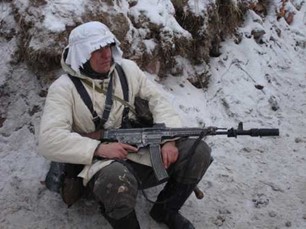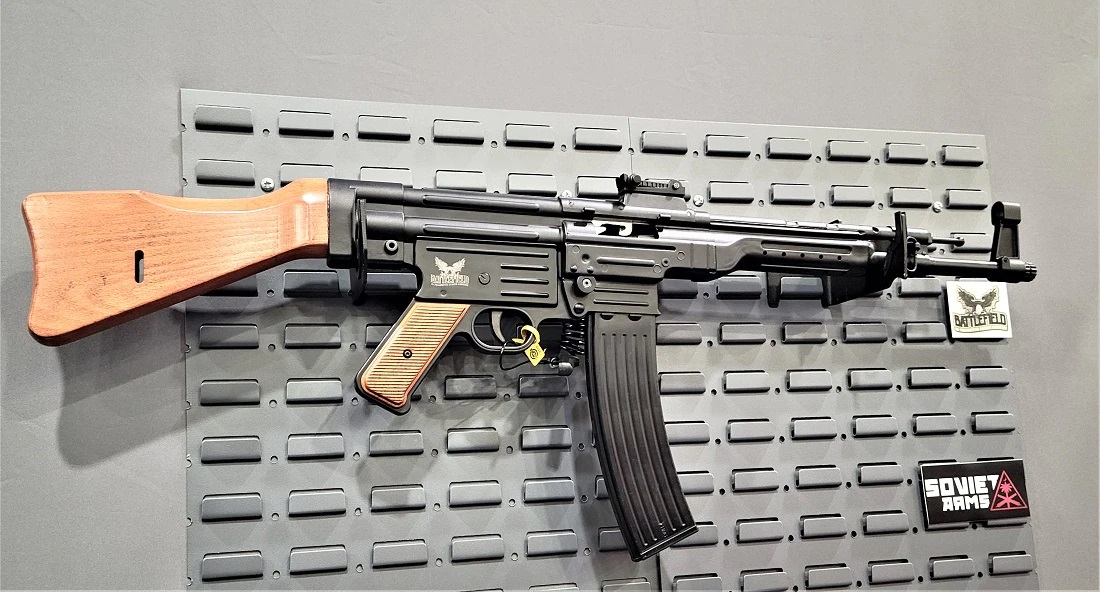By: Warren Gray
Copyright © 2023
“Legendary for its key role in firearms history, the original…StG 44, chambered
in the 7.92x33mm Kurz intermediate cartridge…during World War II was a technological game-changer that helped jump-start the next generation
of infantry weapons used in the second half of the 20th Century.”
— Chris Eger for Guns.com, January 2023.
In 1973, there was an unforgettable TV commercial for the small, low-slung, two-seater Triumph Spitfire 1500 convertible sports car. The delighted owner was driving along a country lane in England with a beautiful, blonde-haired woman in the passenger seat when overhead roared a fully restored World War Two vintage Supermarine Spitfire Mk. IA fighter aircraft. The narrator’s voice said: “With the Triumph Spitfire, you not only get a car and a girl but a piece of history!”
Now, we fast-forward to the SHOT Show in January 2023 and the surprising re-introduction of the classic German Sturmgewehr 44 (“Assault Rifle 44”), developed by Hugo Schmeisser in World War Two. Palmetto State Armory (PSA) has teamed up with Hill & Mac Gunworks (HMG) of Alpharetta, Georgia, to produce an authentic reproduction of the combat-proven StG 44 weapon in PSA’s new Battlefield Series, currently offering gun enthusiasts, reenactors, and collectors a golden opportunity to own another great, World War Two “piece of history.”
The original StG 44 was manufactured only from 1943 to 1945 by four different companies, with 425,977 built for the German Army at that time. It was the world’s first successful “assault rifle,” the standard by which all others have been judged, chambered in the intermediate, 7.92x33mm cartridge, with a 16.5-inch barrel and a 30-round magazine. These features made it more compact than a battle rifle, with a much higher rate of fire, and it was controllable on fully-automatic fire, with effective ranges out as far as 660 yards in semiautomatic mode. The StG 44 successfully combined the characteristics of a carbine, submachine gun, and automatic rifle in a single weapon.

Original StG 44 on display, with ammunition. Photo credit: historyguns.ru.
The brand-new PSA version will be offered instead in 5.56mm NATO, 7.62x39mm, or .300 AAC Blackout, although there are plans to offer the original, 7.92x33mm cartridge, as well, which is still manufactured in Serbia by Prvi Partizan. There are also plans for a shortened StG K model, as well as an StG P pistol variant and folding-stock variants. The preorder price for any of these models ranges from $1,800 to $1,960, depending on the requested model and any options. All should be fully available by the fourth quarter of 2023.
The new StG 44 comes standard with a wooden stock and grip panels, a threaded muzzle (like the original), a long-stroke, piston operating system with a titling bolt, and a drop-in, Heckler and Koch (H&K) trigger group. Calibers can be swapped by the owner by simply changing the barrel, bolt, and magazine.
In World War Two, the StG 44 was first issued in October 1943 to Waffen SS units and the 93rd Infantry Division on the Eastern Front, fighting in Russia, where it proved to be an invaluable asset. One of its primary uses was to counter the Soviet PPS and PPSh-41 submachine guns, which used the 7.62x25mm Tokarev round, and a 71-round drum magazine or 35-round box magazine. These compact weapons were deadly in close-quarter engagements.
With the StG 44, German troops had a devastating, individual weapon with greater range, accuracy, and stopping power than the Soviet submachine guns, which could also provide covering fire like a light machine gun, when required, at a rate of 540 rounds per minute (nine rounds per second). However, soldiers were directed to employ it primarily in semiautomatic mode to conserve ammunition and fire only in short bursts of two or three rounds when utilizing full-auto mode. Due to problems with the magazine follower spring, troops were ordered to load only 25 rounds, and a fixed plug later restricted magazine capacity to 25 rounds.
Due to heavy losses on the Eastern Front, the 1st Infantry Division and 32nd Infantry Division were equipped with StG 44s as their primary weapons, but ammunition shortages meant that only the 1st Division was fully equipped, as planned. It also saw limited service on the Western Front, with Volksgrenadiers in the Ardennes Forest of Belgium and Luxembourg during the Battle of the Bulge in December 1944.

Bundesarchiv, Bild 183-1985-0104-501 / Lange / CC-BY-SA 3.0, CC BY-SA 3.0 DE, via Wikimedia Commons
Some StG 44s were fitted with ZF 4 telescopic sights for sniper purposes, and a crude, night-vision version was created, utilizing a Zielgerät (“Targeting Device”) 1229 infrared (IR) aiming device and codenamed “Vampire,” featuring an IR lamp and scope. It wasn’t widely issued, but the Vampire-equipped StG 44 could sight out to 220 yards in total darkness, and a conical flash hider kept the muzzle flash from blinding the shooter. In addition, the standard, threaded muzzle meant that a suppressor could be attached, although this was actually a seldom-used capability.

StG 44 with four-power, ZF 4 sniper scope. Photo by imfdb.org.

StG 44 with very small suppressor. Photo by ww2incolor.com.
In the 2014 war film “Fury,” starring Brad Pitt as American M4A2E8 Sherman tank commander, Staff Sergeant Don Collier of the 2nd Armored Division, Pitt is repeatedly seen using a captured StG 44. While the sight of American troops carrying German weapons, in reality, was a rare occurrence, it was not impossible, as seen below in the photo of a genuine U.S. soldier in Germany, holding a captured StG 44 in his hands.
After World War Two, the innovative StG 44 was supplied in large numbers to Eastern Bloc nations, including Czechoslovakia, East Germany (police), Hungary, Poland, Romania, and Yugoslavia (paratroopers). They also ended up in the hands of Italian, Polish, and Soviet partisan groups and the French Foreign Legion.
In August 2012, the Syrian Al-Tawhid Brigade displayed a cache of 5,000 StG 44s in their possession, which they had captured from a weapons storage depot in the city of Aleppo. Syrian rebels in the ongoing civil war continue to use StG 44s, and many have been seized from militia groups in neighboring Iraq. Some StG 44s have also been seen in action in the 2014 to 2022 war in Ukraine, probably supplied from old stockpiles of the Czech, German, Hungarian, or Polish governments or Ukrainian WW2 stockpiles.

StG 44 rifle in eastern Ukraine, 2014. Photo by The Firearms Blog.
In any event, the advanced, StG 44 design certainly provided the inspiration for all other assault rifles that came later, including the selective-fire M2 assault carbine introduced in late 1944, the Kalashnikov AK-47 series in 1947, Eugene Stoner and the AR-15/M16 series, since 1959. It was literally decades ahead of its time, and the brand-new PSA StG 44 reproduction, in semiautomatic only, now enables us to own another important piece of firearms history.
* * *
Warren Gray is a retired U.S. Air Force intelligence officer with experience in joint special operations and counterterrorism and is an NRA member. He served in Europe (including four years in Germany) and the Middle East, earned Air Force and Navy parachutist wings, four college degrees, and was a distinguished graduate of the Air Force Intelligence Operations Specialist Course and the USAF Combat Targeting School. He is currently a published author, historian, and hunter. You may visit his website at: warrengray54.vistaprintdigital.com.

